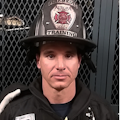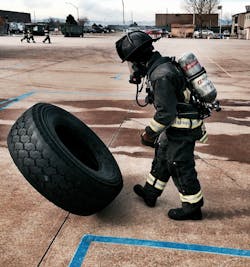The foundation of a prepared firefighter is a fit firefighter, and that’s who the public expects to step off the truck on any given scene.
Firefighter fitness can be best defined by how much work we can do and how quickly we can get it done. That’s what matters most and will lead to positive outcomes on the fireground. We should all be working on increasing the work we can do in as little time as possible. Time is our enemy, and work is our weapon.
Work capacity is defined as what we can accomplish in a given period of time, utilizing multiple body systems—the cardiovascular system, musculoskeletal system, and central nervous system. These systems all work together efficiently to complete a series of tasks, and then recover to do it again.
Timed fitness
Many of us come from athletic backgrounds, and the goal there was to increase the score or put up the lowest time. Our practices and fitness programs were designed to achieve those goals. Today, as firefighters, we are training to increase the chances of survival for the citizens, and the amount of physical work we can do in the first 5 to 20 minutes on scene is critical to the outcome. We need to put up the lowest time possible when completing fireground tasks.
Our fitness programs can no longer look like they did in our younger, sport-playing days. The responsibility is much greater than the win/loss column—it’s life. Every second in which we aren’t making progress on the fireground is a second that victims are closer to death. Time is our biggest enemy, and as such, our fitness programs should include timed fitness. We should be doing more work in less time while improving our ability to recover—and do it again.
Physical demands
When we look at the physical demands of firefighting, we see a mountain of challenges. We fight for life in full PPE, facing temperatures that rob our body of vital fluids and raise our core temperatures to levels that erase recall and pattern recognition. The ability to do the required work in as little time as possible goes beyond the obvious; it gets us in and out of the hostile environment quicker. A high work capacity not only increases our citizens’ chances of survival, but it also lowers the body’s chances of being overwhelmed, both mentally and physically, by the environment.
With this in mind, our fitness program should include time frames and movements that are in line with those of the fireground. Functional compound movements, such as pushing and pulling with the lower and upper body, are the goal. Time frames should be determined by how much time we will get out of our air cylinder. This time can be determined by doing an air-consumption test in full PPE at a work rate that you would expect to have on the fireground. For example, if you determine that you can get 22 minutes out of your cylinder, then your work capacity workouts should be 22 minutes in duration or longer.
It is also important to have at least one day during the week when you do back-to-back work capacity sessions to mimic the rehab and second air cylinder on the fireground. Take a break in between for the amount of time you would expect to be in rehab before returning to work.
Divide your time
Work capacity should make up at least 60 percent of your training, knowing that you will be covering strength and cardio respiratory endurance inside the work capacity training. Work capacity training consistently elevates the heart rate above 70 percent of its max, reaching close to max heart rates in full PPE. This replaces the traditional single cardio exercise and better represents the cardiovascular demand on the fireground. The heart doesn’t know if it’s pushing a sled, climbing stairs or in the middle of an intense work capacity session; it just knows it’s beating 170 beats per minute. The value here is we do functional movement, requiring strength and endurance while capturing the elevated heart rates that we will experience during firefighting.
The remaining 40 percent of our training should be made up of flexibility- and strength-based training. Being strong is important, but being able to move fireground loads in multiple planes in life-saving periods of time should be the goal.
Identify the movements
Training to improve work capacity starts with developing a mindset that every repetition in a workout matters, meaning that every single repetition we do represents life. First, it’s believing that our ability to do a lot of work in a short period of time will make the difference between life and death for others.
We then need to identify movements that will transfer over to the fireground, both in movement and energy system. For example, kettlebell swings, deadlifts, sled pushes and pulls, push press, and ball slams all require a high O2 demand and represent multiple muscle groups working together to move a load at a rate that is consistent with firefighting.
We then string together movements to simulate the fireground demand. For example: 10 kettlebell swings, 10 push press, 10 slam balls and a 50-meter sled push for 22 minutes. Do as many rounds as you can in 22 minutes. Moving through all four movements constitutes one round. The load used will be determined by one’s ability and availability to equipment. We don’t want it to be so light that we aren’t challenged, but we also don’t want it to be so heavy that it forces us to move slower than our fireground pace.
As we increase our work capacity, we will also see an increase in the load we can use and a decrease in the amount of time it takes to do a set amount of work. This type of training will tell you how much work you can do in a given period of time and what to expect to be able to do on the fireground.
Another example is to select a series of functional movements and the number of reps to be completed. A moderate load of 300 reps will typically take 10 to 20 minutes to complete depending on one’s fitness level. Time yourself to see how long it will take to complete the 300 reps. It is important to note that good form is the most important aspect during this type of training. We don’t sacrifice form to go faster; we will only go faster if the form is good. We can then get even closer to the fireground demand by adding turnout gear once a week to our work capacity training; this provides the body the ability to get more comfortable in the heat-trapping and restriction we experience in our gear. Note: It’s important that we use clean, carcinogen-free turnouts during these sessions to prevent exposure.
Build mental toughness
Work capacity training also builds and strengthens our mental toughness—an important quality every firefighter must have. We don’t become mentally tough just because we want to; we become mentally tough because we work to.
Work capacity sessions will test you both mentally and physically, and they will bring you to the point of complete exhaustion on the edge of wanting to quit earlier than the end point of the workout. It’s persevering through this desire to quit that the mind is strengthened. Consistently training to that level makes us better firefighters, both physically and mentally.
There may come a day when we need to dig deep to save a life, or we may be trapped in a basement fighting for survival, but it will be our skills, fitness and mental toughness that will pull us through. Every time we worked to complete exhaustion in training and didn’t quit will provide that needed self-talk of “I’ve been here before.”
In sum
As Jim Moss and Dan Kerrigan state in their book Firefighter Functional Fitness, “If we really want to break down fireground physical activities into a workout, they are basically a combination of high-intensity interval training and strength training.” Therefore, through work capacity training, we build a firefighter's fitness and mind so they can move at the pace required to fight for life.
About the Author

John Spera
John Spera has been a career firefighter/paramedic for over 14 years. He is assigned to the Training Branch at Aurora, CO, Fire Rescue, where his primary responsibility is the health, wellness and fitness of the members within AFR. Spera is the cofounder of Fit to Fight Fire (fittofightfire.com).
